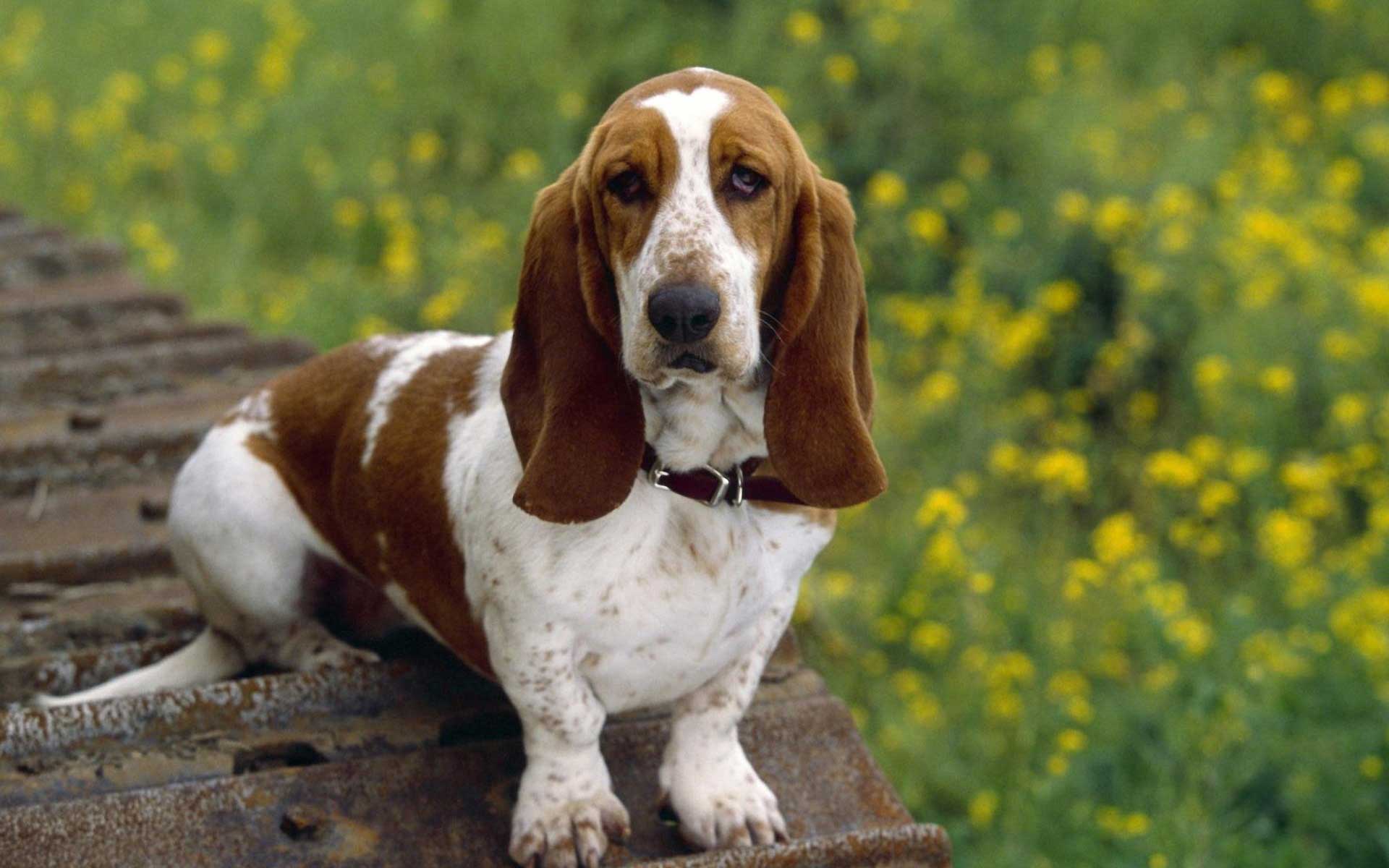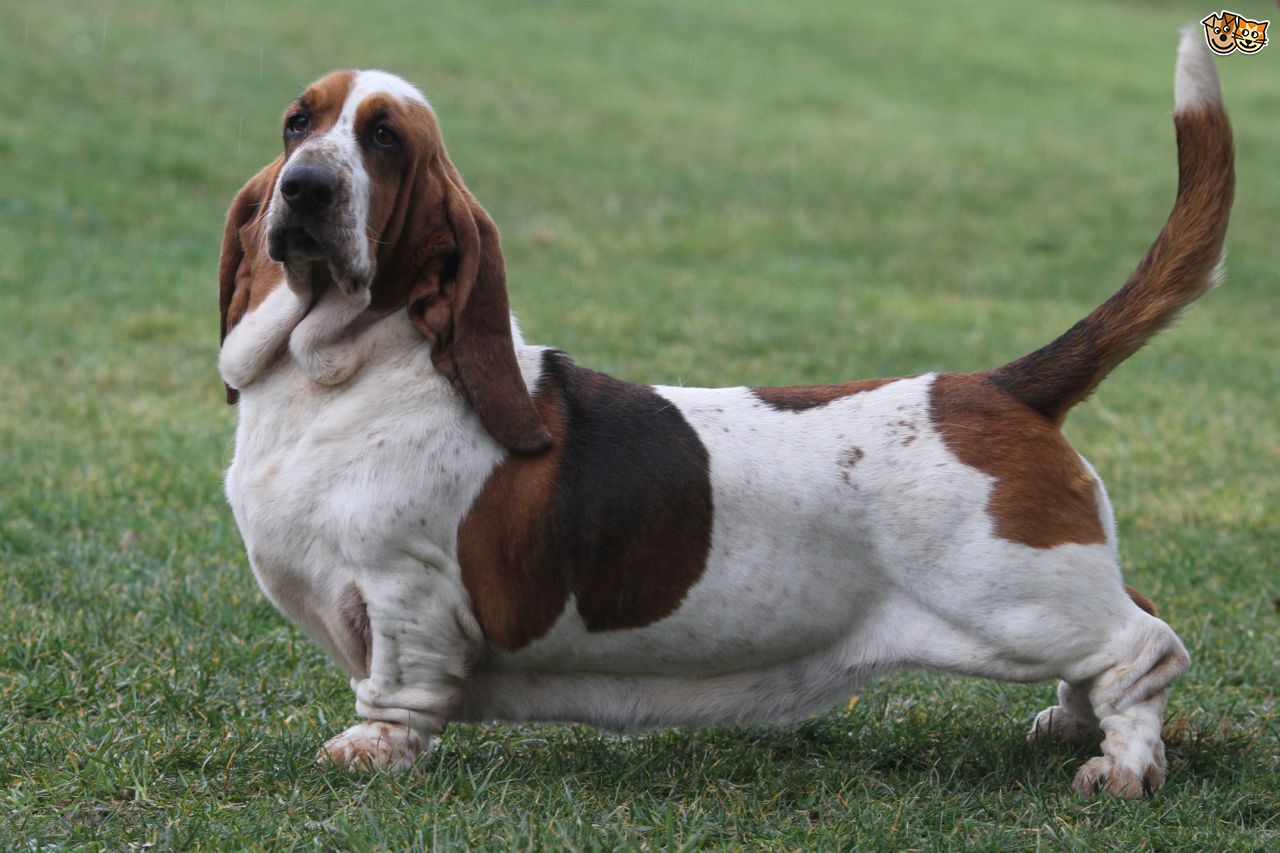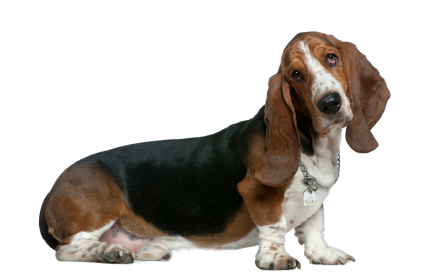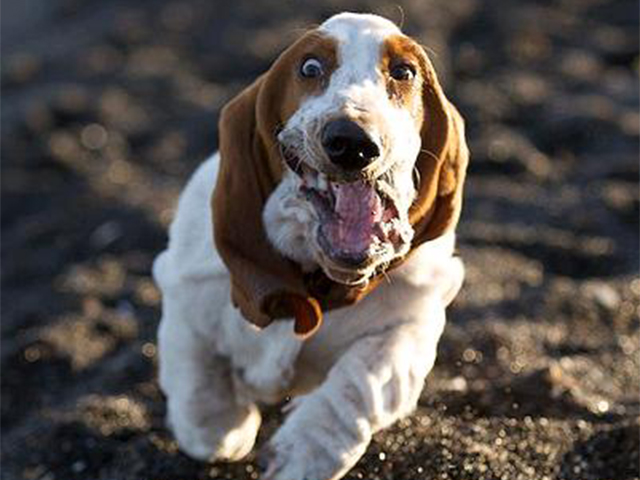
The Breed History
The origins of this breed can be traced back to France and Belgium.
The first written documents to record the breed name "Basset
Hound" date back to the 1580s. The breed name may derive from
the French word for low, "bas". First shown in the late 1800s in
England, the breed was registered with AKC in 1884 and soon
became popular in the USA.
Breeding for Function
These dogs were used to slow trail game such as rabbit, hare and
also sometimes deer. Basset Hounds were prized for their accurate
trailing, especially in thick bush. His nose is considered almost as
outstanding as a Bloodhound's. Earliest records term the breed
"badger hound" indicating their use for badger hunting in the early
phases of breed development, and other accounts report them in
hunts for wolf and boar. Here they were used in packs. For small
game, they were frequently hunted in pairs (termed a brace). They
are seen in field trials and tracking, obedience and are popular as
well as a companion dog.
Physical Characteristics
Height at Withers: less than 14" (35.5 cm).
Weight: 40-60 lb (18-27 kg).
Coat: The dense, short smooth glossy coat is acceptable in any
hound color. Red and white and tricolor are commonly seen.
Longevity: 12 years
Points of Conformation: Their short, very heavily boned legs mean
they are slow moving, but agile. The head is large, and the skull has
a prominent occipital protuberance. They possess a moderate stop,
and skin forms wrinkles on the face when the head is down. The
nose is darkly pigmented. Lips are also of dark pigmentation, and
end in loose flews. A pronounced dewlap is present. The neck is very
muscular and of good length. Eyes are brown and somewhat deep
set. This allows the conjunctivae of the lower lids to show. They are
said to have a sad expression. The ears are very long, pendulous and
low set, with ends curling in. They are deep through the thorax and
ribs are well sprung. The skin is significantly loose and wrinkled over
the carpal and tarsal areas of the limb. Paws are large, rounded, and
slightly deviated laterally from the level of the carpus. Dewclaws
are often removed. The topline is level and tail carriage is typical
for hounds- carried high when on a scent. The tail is thick, slightly
curved and reaches almost to the ground at rest. The gait is easy,
and movement of limbs is parallel.
Recognized Behavior Issues and Traits
Reported breed characteristics include: Gentle, devoted, good for
pack or individual hunting or housing, also excellent in the home.
Has low grooming requirements, is loyal, active, and independent.
The typical mature Basset Hound has moderate exercise needs.
They are also described as stubborn, and must be kept on leash.
They possess a level temperament, are good with children, and can
tend to dig if bored; some are loud alarm barkers. The breed has a
problem in some lines with aggressive, uneven tempered dogs. The
BHCA recommends that all puppies be temperament tested before
placement in homes.
Normal Physiologic Variations
Slow to mature.
They tend to gain weight easily so proper diet and exercise are
essential.
Drug Sensitivities
None reported
Inherited Diseases
Hip Dysplasia: Polygenically inherited trait causing degenerative
joint disease and hip arthritis. OFA reports 37.4% affected.
Elbow Dysplasia: Polygenically inherited trait causing elbow
arthritis. Reported at an increased frequency in the breed, but too
few Basset Hounds have been screened by OFA to determine an
accurate frequency. Reported 19.5x odds ratio for the fragmented
coronoid process form of elbow dysplasia versus other breeds.
Patella Luxation (Slipping Kneecaps): Polygenically inherited
congenital laxity of patellar ligaments, causing luxation, lameness,
and later degenerative joint disease. Treat surgically if causing
clinical signs. Too few Basset Hounds have been screened by OFA to
determine an accurate frequency.
Basset Hound Hereditary Thrombopathy (BHT): An autosomal
recessive bleeding disorder of abnormal platelet function,
characterized by a thrombasthenia-like defect in aggregation but
normal clot retraction. Glycoprotein IIb-IIIa (GP IIb-IIIa) is detectable
in BHT platelets but may be functionally defective. A genetic test is
available.
von Willebrand's Disease: Autosomal recessive, type I form of this
bleeding disorder occurs in the breed. Causes mild, or prolonged
bleeding episodes. A genetic test does not exist in this breed.
X-linked Severe Combined Immunodeficiency (XSCID): Rare,
X-linked recessive disorder, where affected dogs cannot generate
antigen-specific immune responses. A genetic test is available to
identify affected males and carrier females.
Disease Predispositions
Ectropion: Rolling out of eyelids, often with a medial canthal
pocket. Can be secondary to macroblepharon; an abnormally large
eyelid opening. Can also cause conjunctivitis. Ectropion is reported
in 11.17%, and macroblepharon in 1.52% of Basset Hounds CERF
examined by veterinary ophthalmologists between 2000-2005.
Persistent Pupillary Membranes: Strands of fetal remnant
connecting; iris to iris, cornea, lens, or involving sheets of tissue.
The later three forms can impair vision, and dogs affected with
these forms should not be bred. Identified in 5.58% of Basset
Hounds CERF examined by veterinary ophthalmologists between
2000-2005.
Primary (Narrow Angle) Glaucoma: Ocular condition causing
increased pressure within the eyeball, and secondary blindness due
to damage to the retina. Diagnose with tonometry and gonioscopy.
Dorn reports an 8.03x odds ratio for developing glaucoma versus
other breeds. Diagnosed in 5.44% of Basset Hounds presented to
veterinary teaching hospitals.
Hypothyroidism: Inherited autoimmune thyroiditis. 3.5% positive
for thyroid auto-antibodies based on testing at Michigan State
University. (Ave. for all breeds is 7.5%).
Cataracts: Anterior cortex cataracts predominate, though posterior
intermediate and punctate cataracts also occur in the breed.
Unknown mode of inheritance. Identified in 3.38% of Basset
Hounds CERF examined by veterinary ophthalmologists between
2000-2005. CERF does not recommend breeding any Basset Hound
with a cataract.
Distichiasis: Abnormally placed eyelashes that irritate the
cornea and conjunctiva. Can cause secondary corneal ulceration.
Identified in 1.18% of Basset Hounds CERF examined by veterinary
ophthalmologists between 2000-2005.
Gastric Dilation/Volvulus (GDV, Bloat): Life-threatening twisting
of the stomach within the abdomen. Requires immediate veterinary
attention. Occurs at an increased frequency in the breed.
Intervertebral Disk Disease: The breed is at increased risk for acute
paralysis/pain from intervertebral disk extrusion and spinal cord
damage. This is an emergency situation that requires immediate
veterinary attention.
Idiopathic Seborrhea: Occurs at an increased frequency in
the breed, often with concurrent Malassezia pachydermatis
infection.
Temporomandibular Joint (TMJ) Dysplasia: Increased prevalence
in the breed of mandibular subluxation when the mouth is opened
widely, due to TMJ dysplasia. This results in locking of the coronoid
process lateral to the zygomatic arch. Locking can be prevented by
osteotomy of a ventral portion of the zygomatic arch.
Retinal Dysplasia: Focal folds are seen in the breed. Focal folds
were identified in 1.02% of Basset Hounds CERF examined by
veterinary ophthalmologists between 2000-2005.
Persistent Hyaloid Artery: Congenital defect resulting from
abnormalities in the development and regression of the hyaloid
artery. Identified in 1.02% of Basset Hounds CERF examined by
veterinary ophthalmologists between 2000-2005.
Cystinuria/Cystine Bladder Stones: Basset Hounds have an
increased risk for developing cystine bladder stones due to a defect
in cystine metabolism. Treat with surgical removal and life-long
medical therapy. Unknown mode of inheritance in this breed.
Lafora's Disease (Myoclonus Epilepsy): Diagnosed in several
Basset hounds with a progressive central nervous system disease
culminating in epileptic seizures. Histologically, Lafora bodies are
found in neurons and free in the neuropil throughout the cerebrum
and cerebellum.
Allergic Inhalant Dermatitis, Black Hair Follicular Dysplasia,
Brachygnathism, Cervical Vertebral Instability, Corneal
Dystrophy, Dermatomyositis, Dilated Cardiomyopathy, Elongated
Soft palate, Globoid Cell Leukodystrophy, Hemivertebra,
Hypoadrenocorticism, Mycobacterial Susceptibility, Panosteitis,
Progressive Retinal Atrophy, Prolapsed Gland of the Nictitans,
Pulmonic Stenosis, Sebaceous Adentitis, Subaortic Stenosis, and
Wobbler Syndrome are reported.
Isolated Case Studies
Sry-negative XX True Hermaphrodite (XX Sex reversal): A
phenotypically male 7 month old Basset hound was examined. The
chromosomal sex was female (XX), and there was an absence of
"male" causing Sry. XX Sex-reversal is familial in other breeds.
Persistent Hyperplastic Tunica Vasculosa Lentis (PHTVL) and
Persistent Hyaloid Artery: A 2-year-old Basset hound with
unilateral persistent hyperplastic tunica vasculosa lentis and
primary vitreous is described. There was leukokoria in the left
eye, caused by bluish-white polar densities and hemorrhagic
discoloration in the nucleus of the lens.
Persistent Mullerian Duct Syndrome: Diagnosed in a male dog
with oviducts, a uterus, and cranial vaginal tract. Usually caused by
a defective mullerian inhibiting substance (MIS) receptor.
Congenital Hypotrichosis: Four 4 week-old Basset Hound
littermates with predominantly mahogany coats had congenital
focal alopecia especially affecting the head and dorsal pelvic region.
Histologic diagnosis was hypotrichosis.
Genetic Tests
Tests of Genotype: Direct test for XSCID is available from PennGen.
Direct test for thrombopathia is available from
AuburnUniversity:(vetmed.auburn.edu/index.pl/boudreaux_mk)
Tests of Phenotype: BHCA recommends hip and elbow radiographs,
CERF eye examination (including gonioscopy for glaucoma), thyroid
profile including autoantibodies, von Willebrand's factor antigen testing, temperament testing (Puppy Aptitude Testing or American
Temperament Test Society certification), and genetic test for
thrombopathia.
CHIC Certification: Required testing includes CERF eye examination
and gonioscopy (OFA form). Optional testing includes genetic test
for thrombopathia. (See CHIC website; caninehealthinfo.org).
Recommend patella evaluation and cardiac evaluation.
Miscellaneous
- Breed name synonyms: Basset.
- Registries: AKC, UKC, CKC, KCGB (Kennel Club of Great Britain),
ANKC (Australian National Kennel Club), NKC (National Kennel
Club).
- AKC rank (year 2008): 33 (5,277 registered)
- Internet resources: Basset Hound Club of America:
basset-bhca.org
The Bassett Hound Club of Canada:
bassethoundclubofcanada.ca
The Bassett Hound Club (UK): bassethoundclub.co.uk
Photo Gallery of Breed - Basset Hound - Dog Breed








 Animalia Life
Animalia Life